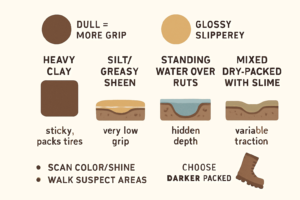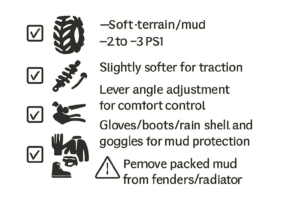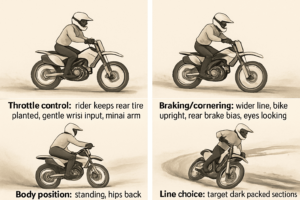If you’re into cool dirt bike mud rides and want to show your skills by riding a dirt bike in muddy terrain? The dry trails are fast and fun, but mud turns out to be pure wetness. Mud is slippery, unpredictable, and demands each of the skills learned and honed over the years. The key is that once you learn to ride in mud, you are going to become a better and more confident rider overall.
This guide will take you through the fundamentals of mud riding, from analyzing the terrain, preparing the bike, and mastering control implementation. These expert tips for mud riding will get you crowned the king of mud.
Table of Contents
ToggleKnow Your Mud: Understanding Conditions Before You Ride
Before mudding with a dirt bike, it is good to know what kind of mud it is. All mud is not the same.
Different Types of Mud
Let’s start with heavy clay, very heavy and sticky, fast to pack into your tires, compromising momentum and maneuverability. Here is slip silt, which resembles a glazed surface and has almost no grip at all.
There may be standing water over rutted trails. The water may appear shallow, yet deep mud or concealed ruts exist underneath. Dried-up patches of mud mixed with slime can suddenly begin to prove treacherous while riding.

Reading the Terrain
The way the terrain looks would signal the rider about the conditions prior to committing to a move. Usually, the wet, shiny-looking mud is extremely slippery, whereas the dull and packed mud has a reasonable grip. Stomp the soft patch with your boot and test for softness.
Keep an eye on color and consistency. Dark, glossy mud may just slide from under your tires, while dry-packed areas might control well. If unsure, walk through the suspect areas first. That small delay could just save the rest of your ride.
Pre-Ride Prep: Gear, Tires, & Bike Setup for Mud
Dirt bikes in mud look awesome, but they need some pre-ride prep. Before starting your ride on mud, here are some necessary steps to take in order to avoid any last-minute inconvenience.
Tires And Dirt Bike Tire Pressure For Mud
A tire makes a tangible difference. The best dirt bike mud tires to use are those designated for soft terrain or mud. Lowering the tire pressure by 2 to 3 PSI improves grip and prevents too much wheel standing.
Suspension and Comfort Control
A softer suspension would be preferred to ensure the wheels stay in touch with any surface, as bouncing tires lose traction. Change the positions of the brake and clutch levers for personal comfort. Muddy gloves can also help reduce the grip.

Basic Guidelines: Riding a Dirt Motorcycle in the Mud and Riding Safely
Now, let’s get into the skills regarding riding a trail dirt bikes in the mud:
Throttle Control
Don’t put in quick throttle bursts. Here, smooth and steady is the way to go in keeping the rear tire planted. Slow and steady progress is better than stopping and starting once again in mid-slip.
Too much throttling and you’re spinning, too little and you want to stall. It’s all feel. Get the feel of the conditions under you, trust your wrist, and listen to the information your bike is giving you. With practice, this eventually becomes second nature.
Body Positioning on the Bike
Drop the center of gravity by standing and allowing the mud bike to move under you. If climbing, lean forward. Slightly backward when descending, but always remain relaxed and ready to change if needed.
Knees slightly bent. Use legs to grip the bike for stability. Let your body act as suspension, soak up all bumps and changes in the terrain. The more you keep yourself flexible and relaxed, the more you will want to maintain your balance.
Breaking the Technique and Cornering
Preferring rear brakes over front, for the grip available to the front tire is usually very limited. Go wide on corners and keep the bike upright. Let your eyes lead you through each corner as smoothly as possible.
Be gentle with your inputs. Sudden braking or being too aggressive with your turns will induce some washouts. Glide the bike in as much as possible and steer toward the turn before braking for it.
Choosing the Proper Line Through Mud
Follow shallow ruts if they are firm. Stay out of the deep ones or the ones filled with water. Feel for packed, darker sections of trail, they generally offer better traction.
Always look ahead where you are going and plan for it. A bad line might drop you into a trench. A good line could be the difference between navigating the very worst terrain.

Advanced Mud Riding Tips for Riders
Once you have the basics down, there are a few advanced techniques that can really take it to the next level of dirt bike mud racing.
Clutch and Torque Management
Feathering the clutch gives one pretty good control in slippery areas. What I really like about engine braking downhill is that you can just let off throttle and stop without breaking traction.
Torque control is especially favorable in tight slippery turns and off-camber sections. A little clutch work gives just enough power for traction.
Getting Through Deep Ruts and Bogs
Pick your line and stick with it. Momentum is key. Don’t look down, keep your eyes up to help balance you and let the bike flow under you.
Allow your front wheel to travel freely through the rut. The handlebars will float in your hands. Don’t fight the movement, let it take you.
Muddy Hill Climbs and Descents
When climbing, stand in a low gear, weight shifted forward. Keep moving steadily without stopping in the climb. For descending hills, keep the bike in a very low gear, lean back slightly, and keep the rear brake together with engine braking.
Pick your line before you even start the climb or descent. Once you get muddy, it’s no easier to stand back up. So just go smooth into it.
Correct Washing of Bikes
The ride did not end when you parked the bike. Use a dirt bike mud scraper to remove the mud. Push through the bearings and other electrical bits with a nice stiff balance hose to the chain, swingarm, radiator, and brake. Always dry up the bike nicely before putting any lube or cleaner. Use a soft brush for scratched areas.
If the mud stays for a long duration, the only obstructing factor with the washdoor will be a huge hindrance. This is why the bike needs to be washed straight after running. Check out the complete guidance on maintaining your dirt bike to get better information.
After Mud Maintenance
Check the Air filter of the muddy dirt bikes first. Watch Sprockets, pads, bearings. Mud without attention rots stuff pretty fast. If mud is your riding companion, surmise the bearings and constantly grease them. Preventive maintenance is a very worthwhile investment to save you from extra repairs.
Store It Like a Bike
Apply anti-corrosion spray to all metal surfaces. Store the bike in a dry place or under a cover so that moisture does not accumulate. Do not put the bike under a plastic tarp. Rust will still develop due to the moisture trapped inside. Airflow is important.
General Mistakes to Avoid
Dirt bike mud riding is really tough and rough, but one may always find an easy passage of trouble through avoidable mistakes.
Bad Speed and Bad Stance
Going too fast makes you lose control, while going too slow can block your momentum. Find your rhythm and stay in a standing position. Sitting reduces both traction and balance.
Let the bike pass under you. Don’t lock your arms and legs. Try to flow with the terrain.
Set up and Control
Know very well how to prepare your bike for mud riding. Plus, good throttle and brake use. Work with your trail, don’t fight it. Sometimes, less is more.
BSEmotors Off-Road Power: Dirt Bikes Set to Conquer the Mud
Looking for a dirt bike that’s ready right out of the box to handle deep mud and rugged terrain? That is what BSEmotors builds its machines to do these days.
High-clearance fenders, waterproof electronics, soft-terrain tires, coupled with heavy-duty suspension. BSEMotors just gave everything required to sustain a muddied ride. Check out our range of dirt bikes and get a customised quote for your business.
FAQ
Can it ruin my engine to ride around in the mud?
Yes. Above all, if mud blocks your filter or radiator. Do clean both after riding.
Are BSEMotors bikes made for Deep Mud or for Enduro?
Certainly, they are made for rough, wet terrain.
How often do I clean my air filter for this mud season?
Every single time after a muddy ride. It is a simple preventative measure against serious engine damage.
Can you put a dual-sport tire to use in muddy conditions?
You can, but expect less grip. Knobby tires designed for soft terrain work far better in deep or slick mud.
Conclusion
Riding through mud fine-tunes the skills, builds confidence, and therefore makes a better rider overall. If it is set up well in terms of control, balance, and the bike, muddy trails quickly become more of an adventure than a chore.
With the right gear and wise technique, all that is left is a mud-tough bike like a BSE, and you’re ready for anything the trail can throw at you. Dirt bike mudding isn’t your enemy. It’s your training ground.
